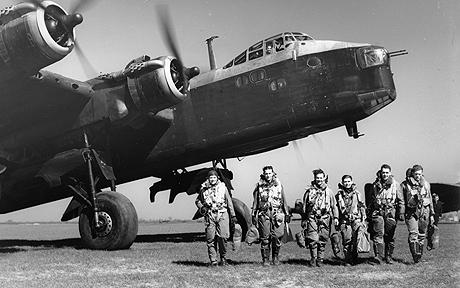The 15 Sqdn left from Mildenhall at 1943-08-18 at 21:10. Loc or duty Peenemunde
He flew with a Short Stirling (type III, serial EE908, code LS-V).
Campaign report of the USAAF:
(Eighth Air Force):: VIII Air Support Command Missions 25A and 25B: Two Luftwaffe airfields are targetted: 1. 36 B-26's are dispatched to Lille/Vendeville Airfield in France; because of mechanical trouble with communications equipment and the bombsight in the lead plane, 22 aircraft bomb the Ypres/Vlamertinge Air- field in Belgium at 1016 hours; 23 aircraft are damaged; there are no casualties. 2. 36 B-26's are dispatched to Woensdrecht Airfield in the Netherlands; 32 hit the target at 1032 hours; 8 aircraft are damaged; there are no casualties.
Campaign report of the RAF:
17/18 August 1943
The Peenemünde Raid
596 aircraft - 324 Lancasters, 218 Halifaxes, 54 Stirlings. This was the first raid in which 6 (Canadian) Group operated Lancaster aircraft. 426 Squadron dispatched 9 Lancaster IIs, losing 2 aircraft including that of the squadron commander, Wing Commander L Crooks, DSO, DFC.
This was a special raid which Bomber Command was ordered to carry out against the German research establishment on the Baltic coast where V2 rockets were being built and tested. The raid was carried out in moonlight to increase the chances of success. There were several novel features:- there was a Master Bomber controlling a full-scale Bomber Command raid for the first time; There were three aiming points - the scientists' and workers' living quarters, the rocket factory and the experimental station; The Pathfinders employed a special plan with crews designated as 'shifters', who attempted to move the marking from one part of the target to another as the raid progressed; Crews of No 5 Group; bombing in the last wave of the attack, had practised the 'time-and-distance' bombing method as an alternative method for their part in the raid.
The Pathfinders found Peenemünde without difficulty in the moonlight and the Master Bomber controlled the raid successfully throughout. A Mosquito diversion to Berlin drew off most of the German night-fighters for the first 2 of the raid's 3 phases. The estimate has appeared in many sources that this raid set back the V-2 experimental programme by at least 2 months and reduced the scale of the eventual rocket attack.
Bomber Command's losses were 40 aircraft - 23 Lancasters, 15 Halifaxes and 2 Stirlings. This represents 6.7 per cent of the force dispatched but was judged an acceptable cost for the successful attack on this important target on a moonlit night. Most of the casualties were suffered by the aircraft of the last wave when the German night fighters arrived in force. This was the first night on which the Germans used their new schräge Musik weapons; these were twin upward-firing cannons fitted in the cockpit of Me 110s. Two schräge Musik aircraft found the bomber stream flying home from Peenemünde and are believed to have shot down 6 of the bombers lost on the raid.
8 Mosquitos carried out a highly successful diversion raid on Berlin. 1 aircraft lost.
18/19 August 1943
30 OTU Wellingtons on leaflet raids to France without loss.
With thanks to the RAF and USAAF.net!
This record can also be found on the maps of Back to Normandy with Google coordinates. You can find the maps by clicking on this link on this location.
There are several possibilities to investigate the flight records on Back to Normandy. All the flights are plotted on maps, sorted "day by day", "by squadron", "by type aircraft", "by year or month", "by location" and much more! Don't miss this!!!
If you have any information that you want to share, please add your comment at the bottom of this record. Or send your information to [email protected]. This information will be added to the record.
Your photos and your information are very welcome! The young do care and with your help we keep up the good work.



